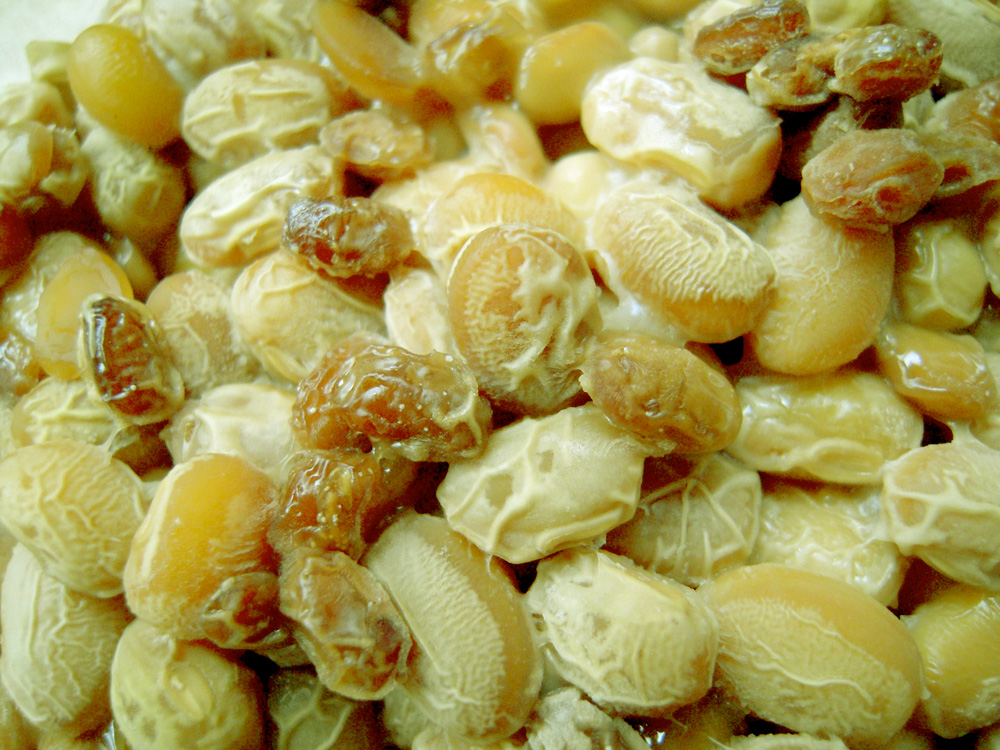
Natto is the one of those foods that elicits strong reactions. I get overwhelmed with a sense of joy and excitement, but the response I hear from most people (who aren't from or aren't descendants of the eastern regions of Japan) is pure disgust.
I remember how clueless I was junior year in college when I stocked up on natto and brought it back to my fridge that I shared with four other UC Santa Cruzers. As I was innocently devouring a package of natto, my roommate barged in yelling "Oh my god! What is that smell?!" My answer to her was, "Are you talking about your pet rat?" as I gestured my chopsticks (all stringy with natto strands) to point at the corner of the room where her pet rat resided. She shook her head and inched in closer to me to inspect the contents of my bowl.
It never registered to me that cold food could smell -- and up until that point, I never suspected that natto even had a smell.
That was my first lesson in how natto could offend people. From that day forward, I could not eat natto so long as I lived with roommates.
Natto is fermented soybeans that were traditionally made in
kotatsus in Japanese homes in the Kanto (Tokyo) region. It's like yogurt in the way that you start with a culture. In the case of natto, the culture used is bacillus subtilis and the medium is soybeans which are left in a humid, warm environment for 24 hours. The result is a mixture of stringy, luscious soybeans that are kind of like a soft cheese in texture with an aroma like no other. Some describe it like smelly French cheese... while my roommates told me it smelled like feet.
Natto is getting some attention because of its health benefits. Eastern regions of Japan have less incidence of osteoporosis. Plus, that sticky stuff apparently contains some enzymes that thin the blood, therefore, preventing heart attacks, strokes and certain types of cancers. I guess they even sell natto in pill form and call it "Nattokinase" here in the west.
My love for natto was evident from my early days -- soon after I exited the womb. But our bond strengthened exponentially when I moved to Tokyo where I could indulge in my love for it with no shame or judgment from my peers. Plus they were regularly priced at a dirt-cheap 30-cents a serving. I would eat a package every morning before dashing off to work. It was like my daily cup of coffee.
So when I came back to the U.S. last month, I braced myself for an environment that would challenge my love affair with natto. It's not that expensive here in California at about $2.00 for three servings, but that's still about twice the amount I was used to in Tokyo. Plus, it's not readily available, say at the local 7-11 or Safeway.
I concluded that the only way I could rely on a steady and affordable supply of natto was to make it myself. My experience with making yogurt for four years, gave me the confidence to try my hand at natto as well.
Here's how I made it:
1) Gather together the following ingredients and supplies: 1 lb of soybeans, a store bought pack of natto, water, glass containers, foil

2) Soak soybeans overnight in plenty of water.

After one night:
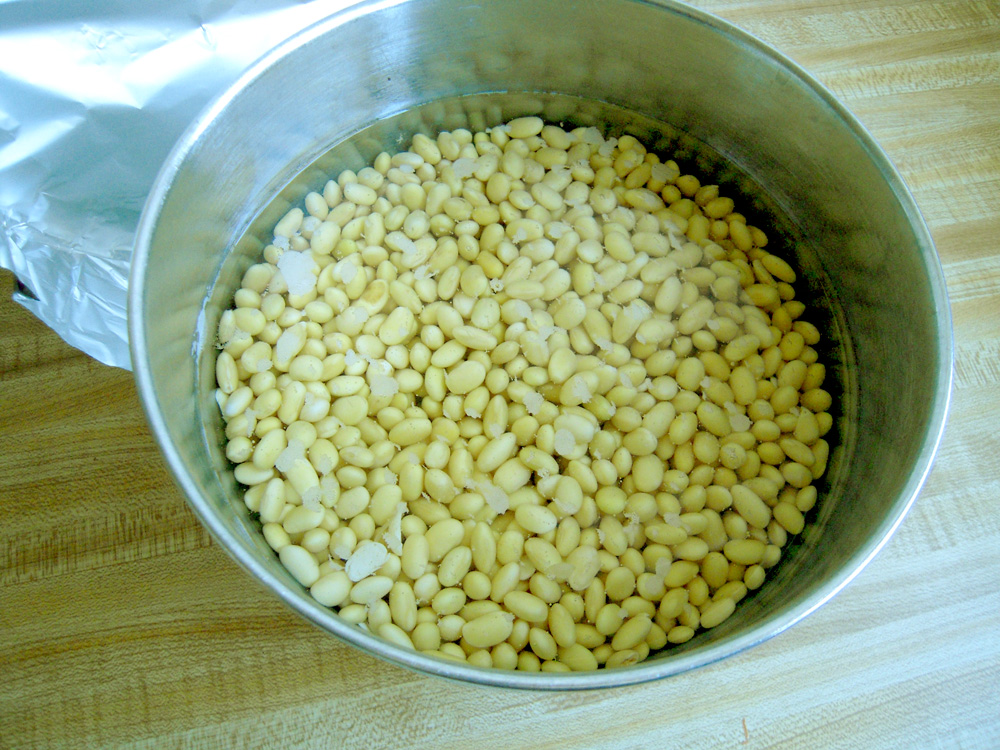
3) Drain the soybeans.
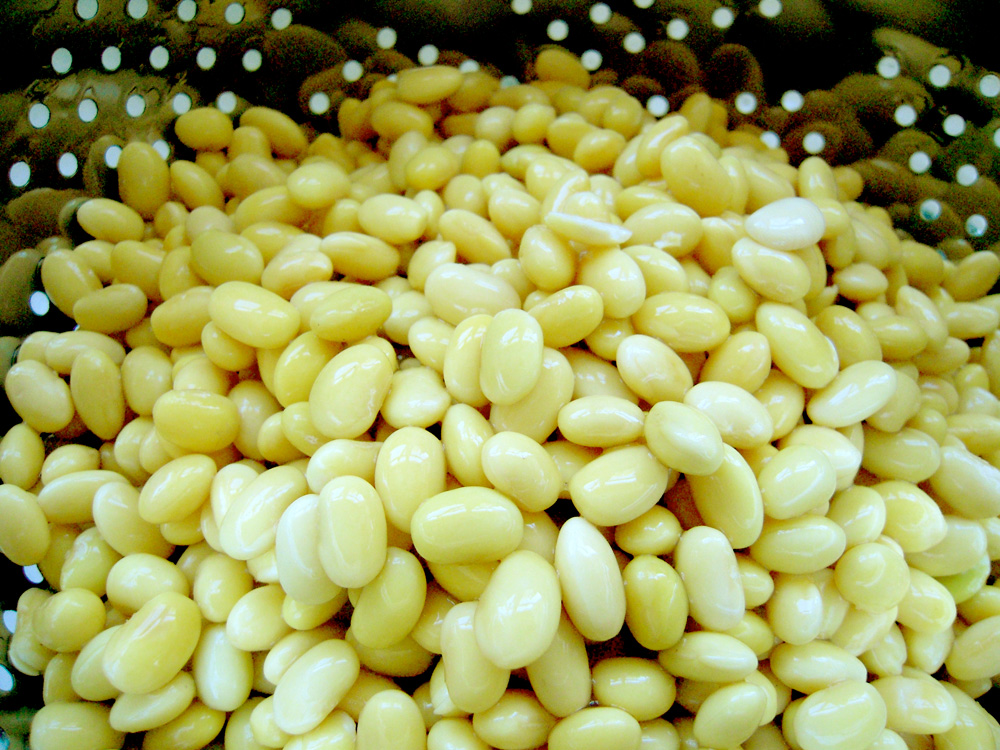
4) Steam the soybeans until you can smush them between your thumb and pointer finger.
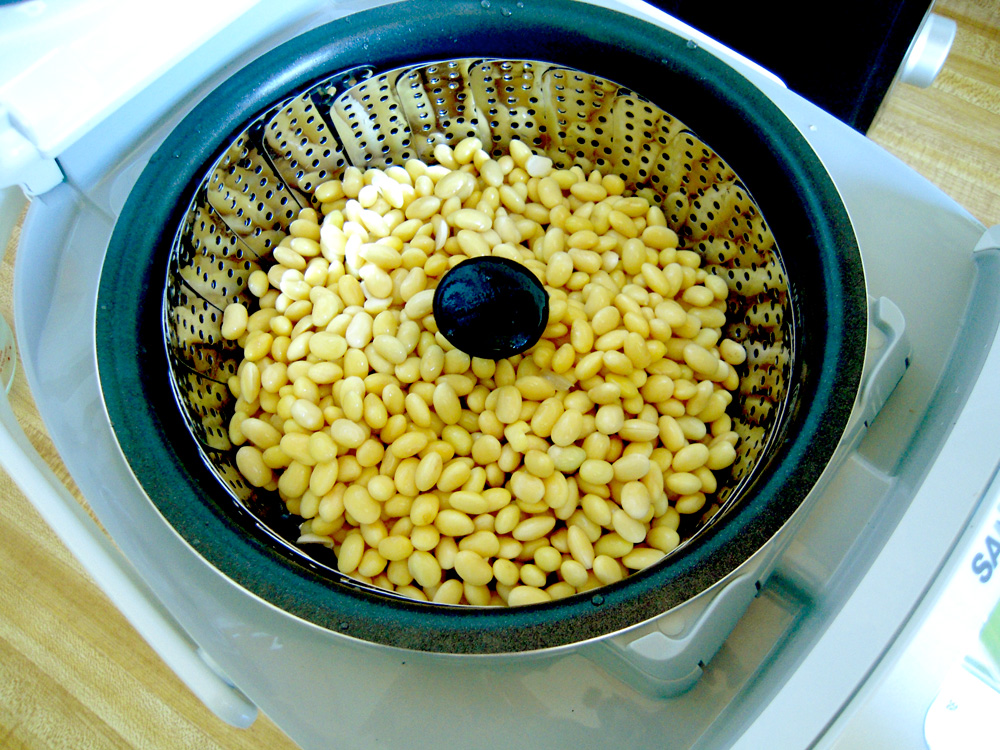
I used my rice cooker which also can act as a pressure cooker. I ended up steaming the soybeans for 40 minutes.
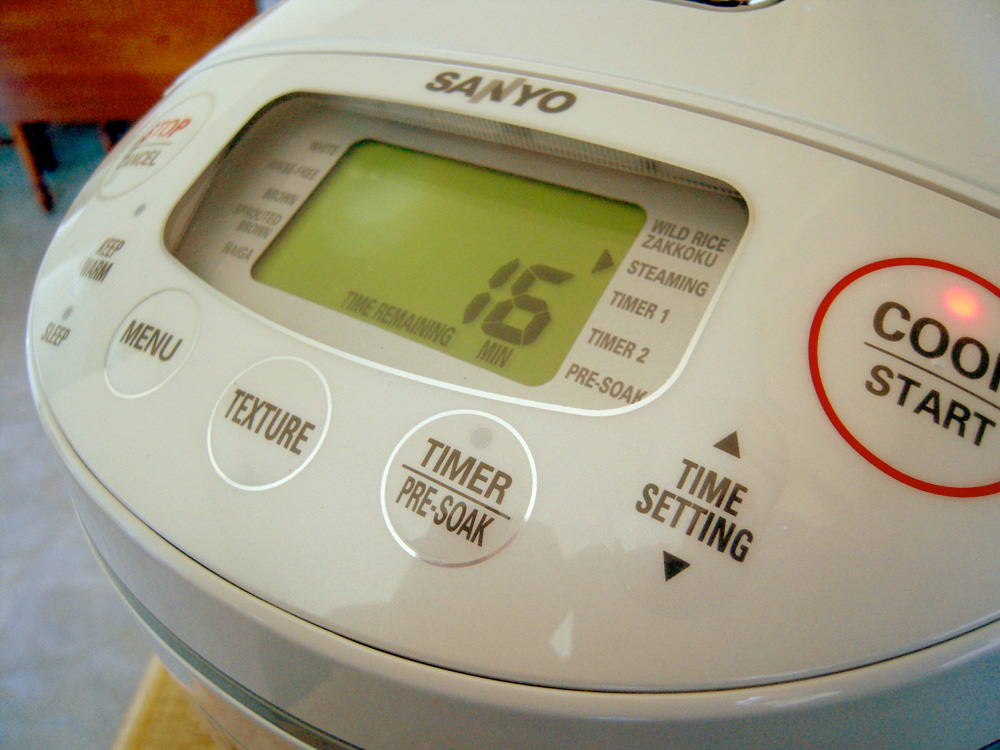
5) While the soybeans are steaming, sterilize the glass containers you will use to ferment the soybeans in. I set my oven to 250 degrees and placed my glass containers in there for about 30 minutes.
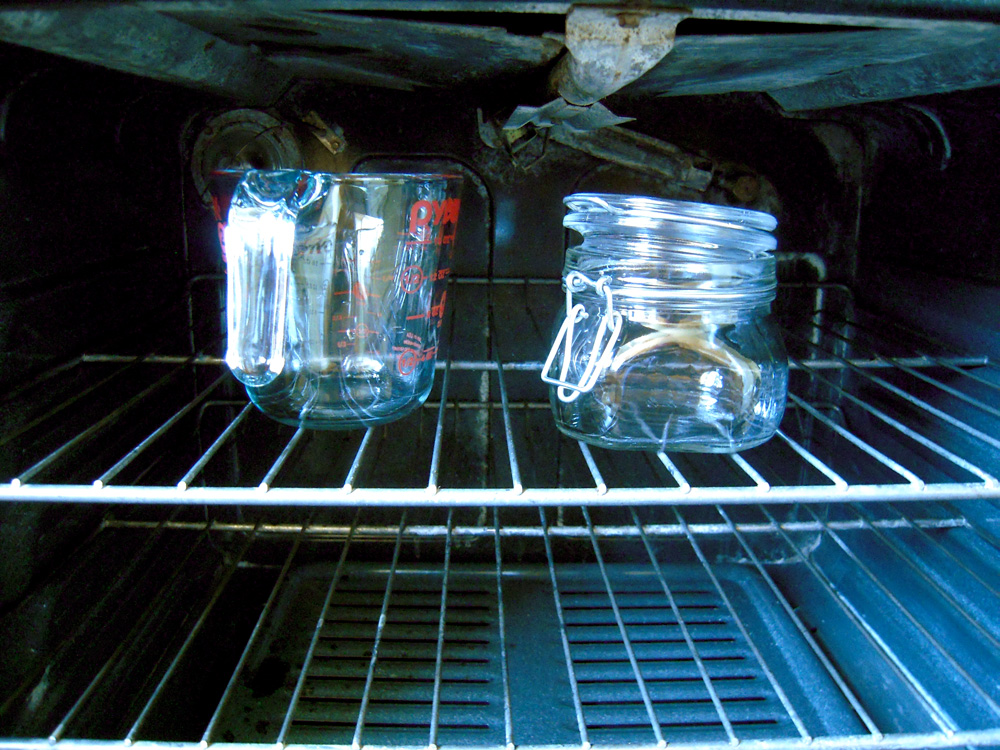
6) Break out the store-bought package of natto.
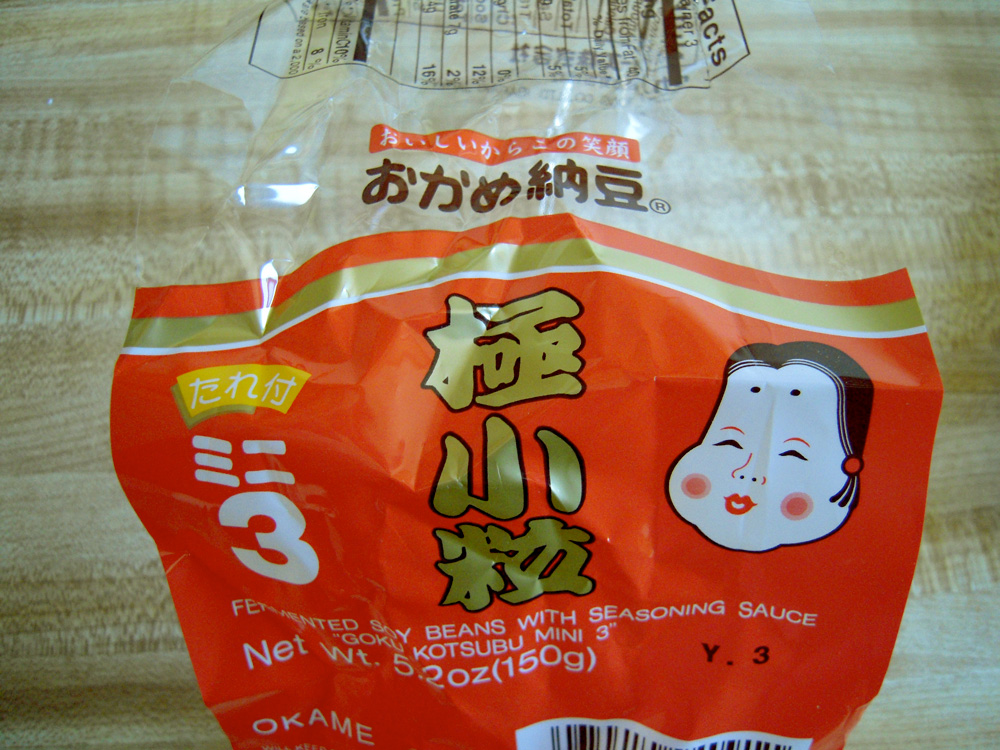

7) Once the soybeans are done steaming, combine them with the store-bought package of natto.

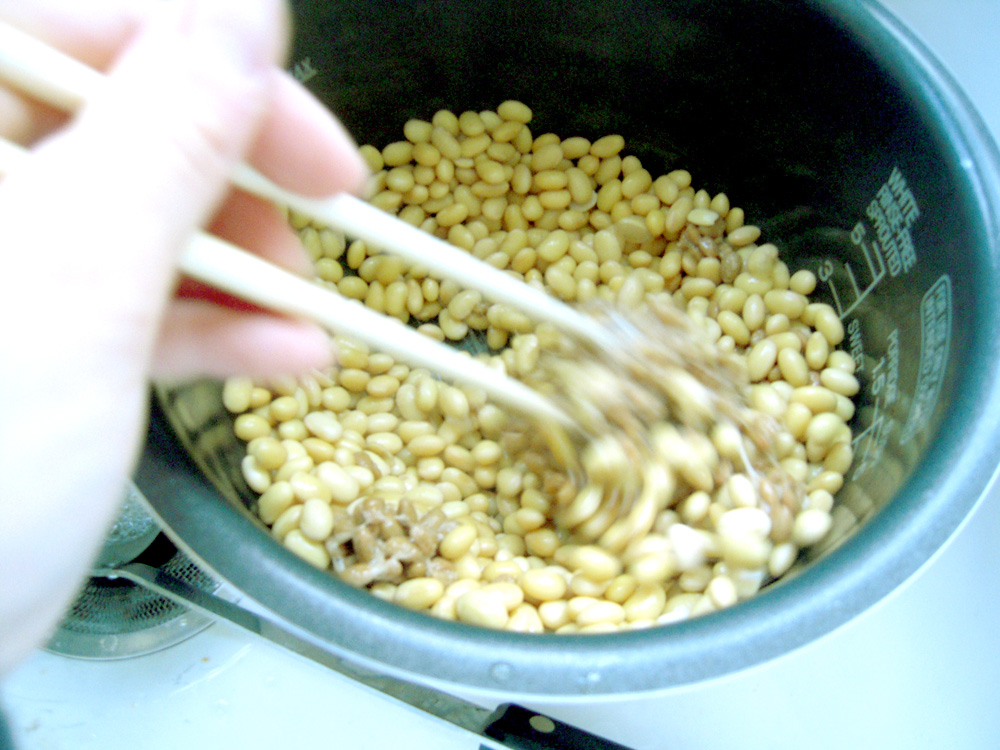
8) Mix well then place the beans into the sterilized jars. Cover the jars with aluminum foil. Poke holes in the foil so that the soybeans can "breathe" during the fermentation process.


9) Okay, the beans are now ready to ferment. The basic idea for creating an ideal environment is to keep the beans in a humid, warm climate at about 40 degrees celsius (think mid-August Tokyo in a small room on the fourth floor with no windows and air conditioning). So I decided to keep the jars in my Crock-pot filled with a little bit of water on the "warm" setting. People also seem to use ice boxes filled with hot water bottles.
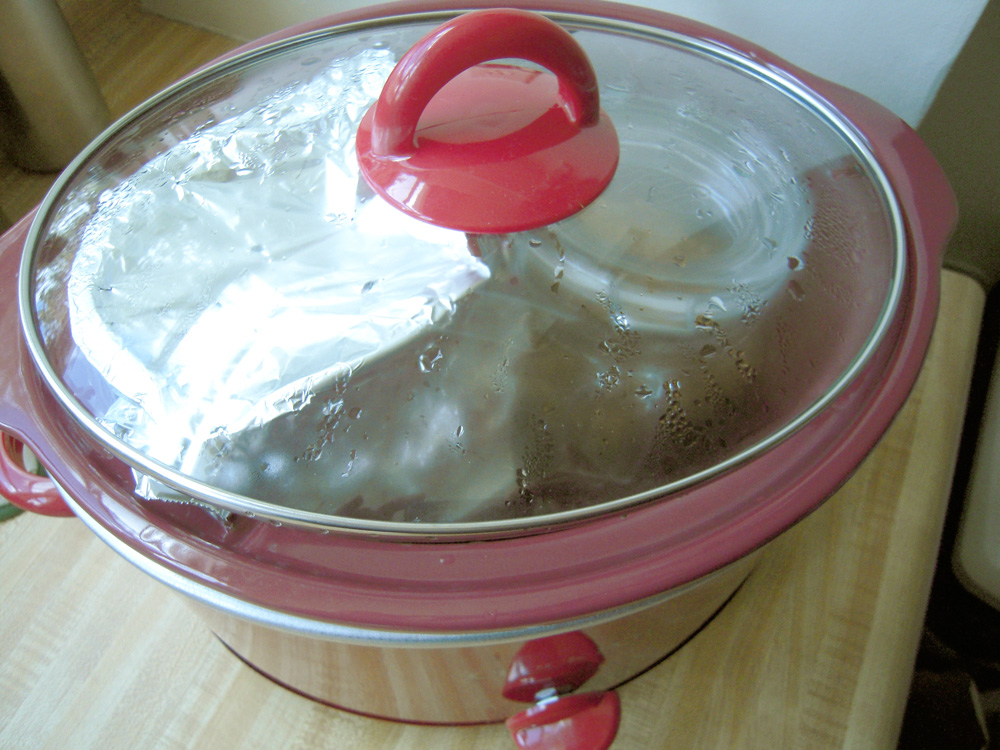
10) Wait for 24 hours.
The suspense got the best of me and I took a peek inside after 12 hours:
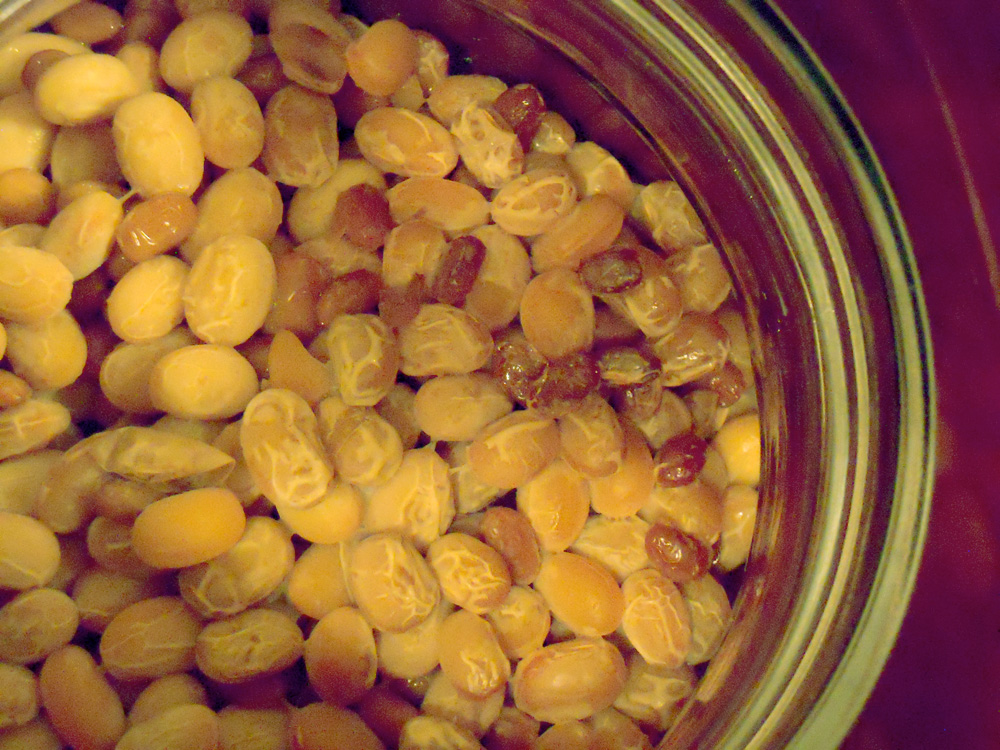
And the next morning they really seemed all mature and grown up.

Look at the stringiness!!! I was a very proud parent.

11) But the wait was not over. These beads of joy must be aged for umami in air-tight containers for a few days to one week in the refrigerator.
12) I finally got to indulge today over rice and I experienced a deep sense of pride and accomplishment. With a dash of soy sauce and Japanese mustard mixed into my home-made natto, I knew I had achieved nirvana for my taste buds and wallet.


13) To complete the cycle, freeze a portion of the natto to use as the starter for the next batch of natto.
 Natto is the one of those foods that elicits strong reactions. I get overwhelmed with a sense of joy and excitement, but the response I hear from most people (who aren't from or aren't descendants of the eastern regions of Japan) is pure disgust.
I remember how clueless I was junior year in college when I stocked up on natto and brought it back to my fridge that I shared with four other UC Santa Cruzers. As I was innocently devouring a package of natto, my roommate barged in yelling "Oh my god! What is that smell?!" My answer to her was, "Are you talking about your pet rat?" as I gestured my chopsticks (all stringy with natto strands) to point at the corner of the room where her pet rat resided. She shook her head and inched in closer to me to inspect the contents of my bowl.
It never registered to me that cold food could smell -- and up until that point, I never suspected that natto even had a smell.
That was my first lesson in how natto could offend people. From that day forward, I could not eat natto so long as I lived with roommates.
Natto is fermented soybeans that were traditionally made in kotatsus in Japanese homes in the Kanto (Tokyo) region. It's like yogurt in the way that you start with a culture. In the case of natto, the culture used is bacillus subtilis and the medium is soybeans which are left in a humid, warm environment for 24 hours. The result is a mixture of stringy, luscious soybeans that are kind of like a soft cheese in texture with an aroma like no other. Some describe it like smelly French cheese... while my roommates told me it smelled like feet.
Natto is getting some attention because of its health benefits. Eastern regions of Japan have less incidence of osteoporosis. Plus, that sticky stuff apparently contains some enzymes that thin the blood, therefore, preventing heart attacks, strokes and certain types of cancers. I guess they even sell natto in pill form and call it "Nattokinase" here in the west.
My love for natto was evident from my early days -- soon after I exited the womb. But our bond strengthened exponentially when I moved to Tokyo where I could indulge in my love for it with no shame or judgment from my peers. Plus they were regularly priced at a dirt-cheap 30-cents a serving. I would eat a package every morning before dashing off to work. It was like my daily cup of coffee.
So when I came back to the U.S. last month, I braced myself for an environment that would challenge my love affair with natto. It's not that expensive here in California at about $2.00 for three servings, but that's still about twice the amount I was used to in Tokyo. Plus, it's not readily available, say at the local 7-11 or Safeway.
I concluded that the only way I could rely on a steady and affordable supply of natto was to make it myself. My experience with making yogurt for four years, gave me the confidence to try my hand at natto as well.
Here's how I made it:
1) Gather together the following ingredients and supplies: 1 lb of soybeans, a store bought pack of natto, water, glass containers, foil
Natto is the one of those foods that elicits strong reactions. I get overwhelmed with a sense of joy and excitement, but the response I hear from most people (who aren't from or aren't descendants of the eastern regions of Japan) is pure disgust.
I remember how clueless I was junior year in college when I stocked up on natto and brought it back to my fridge that I shared with four other UC Santa Cruzers. As I was innocently devouring a package of natto, my roommate barged in yelling "Oh my god! What is that smell?!" My answer to her was, "Are you talking about your pet rat?" as I gestured my chopsticks (all stringy with natto strands) to point at the corner of the room where her pet rat resided. She shook her head and inched in closer to me to inspect the contents of my bowl.
It never registered to me that cold food could smell -- and up until that point, I never suspected that natto even had a smell.
That was my first lesson in how natto could offend people. From that day forward, I could not eat natto so long as I lived with roommates.
Natto is fermented soybeans that were traditionally made in kotatsus in Japanese homes in the Kanto (Tokyo) region. It's like yogurt in the way that you start with a culture. In the case of natto, the culture used is bacillus subtilis and the medium is soybeans which are left in a humid, warm environment for 24 hours. The result is a mixture of stringy, luscious soybeans that are kind of like a soft cheese in texture with an aroma like no other. Some describe it like smelly French cheese... while my roommates told me it smelled like feet.
Natto is getting some attention because of its health benefits. Eastern regions of Japan have less incidence of osteoporosis. Plus, that sticky stuff apparently contains some enzymes that thin the blood, therefore, preventing heart attacks, strokes and certain types of cancers. I guess they even sell natto in pill form and call it "Nattokinase" here in the west.
My love for natto was evident from my early days -- soon after I exited the womb. But our bond strengthened exponentially when I moved to Tokyo where I could indulge in my love for it with no shame or judgment from my peers. Plus they were regularly priced at a dirt-cheap 30-cents a serving. I would eat a package every morning before dashing off to work. It was like my daily cup of coffee.
So when I came back to the U.S. last month, I braced myself for an environment that would challenge my love affair with natto. It's not that expensive here in California at about $2.00 for three servings, but that's still about twice the amount I was used to in Tokyo. Plus, it's not readily available, say at the local 7-11 or Safeway.
I concluded that the only way I could rely on a steady and affordable supply of natto was to make it myself. My experience with making yogurt for four years, gave me the confidence to try my hand at natto as well.
Here's how I made it:
1) Gather together the following ingredients and supplies: 1 lb of soybeans, a store bought pack of natto, water, glass containers, foil
 2) Soak soybeans overnight in plenty of water.
2) Soak soybeans overnight in plenty of water.
 After one night:
After one night:
 3) Drain the soybeans.
3) Drain the soybeans.
 4) Steam the soybeans until you can smush them between your thumb and pointer finger.
4) Steam the soybeans until you can smush them between your thumb and pointer finger.
 I used my rice cooker which also can act as a pressure cooker. I ended up steaming the soybeans for 40 minutes.
I used my rice cooker which also can act as a pressure cooker. I ended up steaming the soybeans for 40 minutes.
 5) While the soybeans are steaming, sterilize the glass containers you will use to ferment the soybeans in. I set my oven to 250 degrees and placed my glass containers in there for about 30 minutes.
5) While the soybeans are steaming, sterilize the glass containers you will use to ferment the soybeans in. I set my oven to 250 degrees and placed my glass containers in there for about 30 minutes.
 6) Break out the store-bought package of natto.
6) Break out the store-bought package of natto.

 7) Once the soybeans are done steaming, combine them with the store-bought package of natto.
7) Once the soybeans are done steaming, combine them with the store-bought package of natto.

 8) Mix well then place the beans into the sterilized jars. Cover the jars with aluminum foil. Poke holes in the foil so that the soybeans can "breathe" during the fermentation process.
8) Mix well then place the beans into the sterilized jars. Cover the jars with aluminum foil. Poke holes in the foil so that the soybeans can "breathe" during the fermentation process.

 9) Okay, the beans are now ready to ferment. The basic idea for creating an ideal environment is to keep the beans in a humid, warm climate at about 40 degrees celsius (think mid-August Tokyo in a small room on the fourth floor with no windows and air conditioning). So I decided to keep the jars in my Crock-pot filled with a little bit of water on the "warm" setting. People also seem to use ice boxes filled with hot water bottles.
9) Okay, the beans are now ready to ferment. The basic idea for creating an ideal environment is to keep the beans in a humid, warm climate at about 40 degrees celsius (think mid-August Tokyo in a small room on the fourth floor with no windows and air conditioning). So I decided to keep the jars in my Crock-pot filled with a little bit of water on the "warm" setting. People also seem to use ice boxes filled with hot water bottles.
 10) Wait for 24 hours.
The suspense got the best of me and I took a peek inside after 12 hours:
10) Wait for 24 hours.
The suspense got the best of me and I took a peek inside after 12 hours:
 And the next morning they really seemed all mature and grown up.
And the next morning they really seemed all mature and grown up.
 Look at the stringiness!!! I was a very proud parent.
Look at the stringiness!!! I was a very proud parent.
 11) But the wait was not over. These beads of joy must be aged for umami in air-tight containers for a few days to one week in the refrigerator.
12) I finally got to indulge today over rice and I experienced a deep sense of pride and accomplishment. With a dash of soy sauce and Japanese mustard mixed into my home-made natto, I knew I had achieved nirvana for my taste buds and wallet.
11) But the wait was not over. These beads of joy must be aged for umami in air-tight containers for a few days to one week in the refrigerator.
12) I finally got to indulge today over rice and I experienced a deep sense of pride and accomplishment. With a dash of soy sauce and Japanese mustard mixed into my home-made natto, I knew I had achieved nirvana for my taste buds and wallet.

 13) To complete the cycle, freeze a portion of the natto to use as the starter for the next batch of natto.
13) To complete the cycle, freeze a portion of the natto to use as the starter for the next batch of natto.




Comments (52)
Thanks for the great instruction page!
I am interested in trying to make this! I just read about the specific health angle eating this can offer involving vitamin K2. Without K2 as a regular part of the diet Calcium can end up killing you because K2 is needed to direct it into the bones. (it is actually more complicated than this involving vitamin D and E too but….) Suffice it to say that otherwise too much gets stuck to your blood vessels! Natto provides what would have to come from dairy or meat or eggs and none of these have vitamin K2 anymore unless the diet of the producing animals are truly pasture raised!! Good luck finding pasture raised anythig anymore at a reasonable cost.
Abe
Thank you so much for a great recipe. I was always afraid to try to make it myself but it was a snap following your directions. I used an oven with a 60 watt bulb and a tray of water for the incubation period and it turned out super. Now I can eat as much as I have always wanted but could not afford.
I just finished today a batch of chickpea-natto. The smell in the container under the plastic wrap was like ammonia. At the moment it’s outside to get rid of it, afterwards I put it in the fride.
When I tasted it, it’s like heaven, the smell disapears and it’s nice and slimy :)
Actually, I seem to like chickpea natto better than the soybean natto.
Though, the chickpeas didn’t get the wrinkles as the soybeans did even though I had them more than 50 hours in the oven at the recommended 40° Celsius. The slime looks normal.
My first batch was soybean natto, but that didn’t had this strong ammonia smell. After 30h it was really wrinkly and had lots of the slimy stuff.
btw
I only use like a small portion of a packaged natto, like 20 beans (over here the cheapest 3 portion package costs almost 6$).
I put it in 1dl of luke warm boiled water and added 1 tablespoon sugar and a little salt (as I do to make yeast grow to bake bread) then I poured it over the cooked beans and stired them.
That seems to produce lots and lots of the slimy stuff :-)
I’m in hour 12 or so of making my natto. I tried this method with the natto spores and I’m concerned that I may have killed off the spores before I even put my jars in the crock pot to keep warm. I’m also hoping that my warm setting didn’t kill off all of my culture by being too warm. Does this method only work with the package natto as a starter? Will the packaged natto still work if it was frozen? Thank you for your awesome blog!
Way too much work to make it. It’s so cheap to buy it in Canada. It’s only 1.99$ on sale for a pack of 4 styryfoam.
I add condiments and green onions among other crunchy things like croutons with my natto in the morning.
I wrote an article on my natto experience here. Check it out. http://foodstochew.com/my-week-with-natto-san/
I am so excited to try making my own natto. My Japanese mother would have been so proud. Domo aarigato gozaimashita.
I’m starting to make natto, I saw a posting by using google. It involves steaming by pressure cooker, then using a machine available only in Japan(100V), brand is Yogurtia by Tanica Ym-1200. it’s available in Amazon but pricey upward of $110. I’ll try yours since i’ve already the pressure cooker & crockpot. I think its more economical to use as starter the fermentation package than the natto .
Do I need just one styrofoam pack of natto? Or all three packs? Thanks in advance!
Betsy, just use one styrofoam pack!
If you don’t like the ammonia smell/taste, (yes, it should smell or taste a little bit like ammonia – like a strong brie mould!), then prepare your natto by mixing with a little vinegar befare adding to anything else. Vinegar neutralizes the pungency and makes it more palatable if you don’t like it. My Japanese friends use rige wine vinegar, but if you mix it in Italian food, for instance, you use balsamic – whatever vinegar is appropriate to the cuisine.